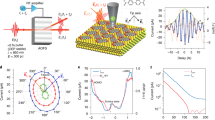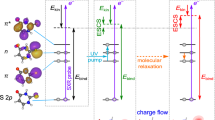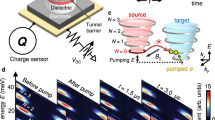Abstract
The superposition of quantum states drives motion on the atomic and subatomic scales, with the energy spacing of the states dictating the speed of the motion. In the case of electrons residing in the outer (valence) shells of atoms and molecules which are separated by electronvolt energies, this means that valence electron motion occurs on a subfemtosecond to few-femtosecond timescale (1 fs = 10−15 s). In the absence of complete measurements, the motion can be characterized in terms of a complex quantity, the density matrix. Here we report an attosecond pump–probe measurement of the density matrix of valence electrons in atomic krypton ions1. We generate the ions with a controlled few-cycle laser field2 and then probe them through the spectrally resolved absorption of an attosecond extreme-ultraviolet pulse3, which allows us to observe in real time the subfemtosecond motion of valence electrons over a multifemtosecond time span. We are able to completely characterize the quantum mechanical electron motion and determine its degree of coherence in the specimen of the ensemble. Although the present study uses a simple, prototypical open system, attosecond transient absorption spectroscopy should be applicable to molecules and solid-state materials to reveal the elementary electron motions that control physical, chemical and biological properties and processes.
This is a preview of subscription content, access via your institution
Access options
Subscribe to this journal
Receive 51 print issues and online access
$199.00 per year
only $3.90 per issue
Buy this article
- Purchase on Springer Link
- Instant access to full article PDF
Prices may be subject to local taxes which are calculated during checkout





Similar content being viewed by others
References
Rohringer, N. & Santra, R. Multichannel coherence in strong-field ionization. Phys. Rev. A 79, 053402 (2009)
Baltuska, A. et al. Attosecond control of electronic processes by intense light fields. Nature 421, 611–615 (2003)
Hentschel, M. et al. Attosecond metrology. Nature 414, 509–513 (2001)
Zewail, A. H. Femtochemistry: atomic-scale dynamics of the chemical bond. J. Phys. Chem. A 104, 5660–5694 (2000)
Schöffler, M. S. et al. Ultrafast probing of core hole localization in N2 . Science 320, 920–923 (2008)
Niikura, H. et al. Sub-laser-cycle electron pulses for probing molecular dynamics. Nature 417, 917–922 (2002)
Niikura, H. et al. Probing molecular dynamics with attosecond resolution using correlated wave packet pairs. Nature 421, 826–829 (2002)
Niikura, H., Villeneuve, D. M. & Corkum, P. B. Mapping attosecond electron wave packet motion. Phys. Rev. Lett. 94, 083003 (2005)
Baker, S. et al. Probing proton dynamics in molecules on an attosecond time scale. Science 312, 424–427 (2006)
Smirnova, O. et al. High harmonic interferometry of multi-electron dynamics in molecules. Nature 460, 972–977 (2009)
Kienberger, R. et al. Atomic transient recorder. Nature 427, 817–821 (2004)
Sansone, G. et al. Isolated single-cycle attosecond pulses. Science 314, 443–446 (2006)
Goulielmakis, E. et al. Single-cycle nonlinear optics. Science 320, 1614–1617 (2008)
Brabec, T. Strong Field Laser Physics (Springer, 2008)
Yudin, G. L. et al. Attosecond photoionization of coherently coupled electronic states. Phys. Rev. A 72, 051401 (2005)
Pollard, W. T., Lee, S.-Y. & Mathies, R. A. Wave packet theory of dynamic absorption spectra in femtosecond pump-probe experiments. J. Chem. Phys. 92, 4012–4029 (1990)
Mathies, R. A. et al. Direct observation of the femtosecond excited-state cis-trans isomerization in bacteriorhodopsin. Science 240, 777–779 (1988)
Loh, Z.-H. et al. Quantum state-resolved probing of strong-field-ionized xenon atoms using femtosecond high-order harmonic transient absorption spectroscopy. Phys. Rev. Lett. 98, 143601 (2007)
Loh, Z.-H. & Leone, S. R. Ultrafast strong-field dissociative ionization dynamics of CH2Br2 probed by femtosecond soft X-ray transient absorption spectroscopy. J. Chem. Phys. 128, 204302 (2008)
Southworth, S. H. et al. K-edge X-ray-absorption spectroscopy of laser-generated Kr+ and Kr2+ . Phys. Rev. A 76, 043421 (2007)
Jurvansuu, M., Kivimäki, A. & Aksela, S. Inherent lifetime widths of Ar 2p−1, Kr 3d−1, Xe 3d−1, and Xe 4d−1 states. Phys. Rev. A 64, 012502 (2001)
Drescher, M. et al. Time-resolved atomic inner-shell spectroscopy. Nature 419, 803–807 (2002)
Rottke, H., Ludwig, J. & Sandner, W. ‘Short’ pulse MPI of xenon: the 2P 1/2 ionization channel. J. Phys. B 29, 1479 (1996)
Gubbini, E. et al. Core relaxation in atomic ultrastrong laser field ionization. Phys. Rev. Lett. 94, 053602 (2005)
Young, L. et al. X-ray microprobe of orbital alignment in strong-field ionized atoms. Phys. Rev. Lett. 97, 083601 (2006)
Saloman, E. B. Energy levels and observed spectral lines of krypton, Kr I through Kr XXXVI. J. Phys. Chem. Ref. Data 36, 215–386 (2007)
Santra, R., Dunford, R. W. & Young, L. Spin-orbit effect on strong-field ionization of krypton. Phys. Rev. A 74, 043403 (2006)
Jones, R. R. & Noordam, L. D. Electronic wavepackets. Adv. At. Mol. Opt. Phys. 38, 1–38 (1998)
Bucksbaum, P. H. The future of attosecond spectroscopy. Science 317, 766–769 (2007)
Krausz, F. & Ivanov, M. Y. Attosecond physics. Rev. Mod. Phys. 81, 163–234 (2009)
Acknowledgements
We thank U. Kleineberg, M. Hofstetter and M. Fiess for invaluable contributions. This work was supported by the Max Planck Society, the Nobel Program of King Saud University and the DFG Cluster of Excellence: Munich Centre for Advanced Photonics (http://www.munich-photonics.de). E.G. acknowledges a Marie-Curie Reintegration grant (MERG-CT-2007-208643). A.W., S.Z. and M.F.K. acknowledge support by the Emmy Noether programme of the DFG. Z.-H.L., T.P. and S.R.L. acknowledge support from the Air Force Office of Scientific Research (FA9550-04-1-0242), the National Science Foundation (CHE-0742662 and EEC-0310717) and the Director, Office of Science, Office of Basic Energy Sciences, US Department of Energy (DE-AC02-05-CH11231). T.P. acknowledges support from the MPRG program of the MPG. R.S. is supported by the Office of Basic Energy Sciences, Office of Science, US Department of Energy (DE-AC02-06CH11357). Part of this work was performed under the auspices of the US Department of Energy by Lawrence Livermore National Laboratory (DE-AC52-07NA27344). S.R.L. gratefully acknowledges appointment as a Miller Research Professor in the Miller Institute for Basic Research in Science.
Author information
Authors and Affiliations
Contributions
E.G., Z.-H.L. and A.W. conceived and designed the experiments; E.G., A.W. and Z.-H.L. performed the measurements; A.W., Z.-H.L., E.G., T.P., S.Z., A.M.A., M.F.K., S.R.L and F.K. evaluated, analysed and interpreted the experimental data; and R.S., N.R. and V.S.Y. performed the theoretical modelling. All authors discussed the results and contributed to the final manuscript.
Corresponding authors
Supplementary information
Supplementary Information
This file contains Supplementary Data and a Reference. (PDF 219 kb)
Rights and permissions
About this article
Cite this article
Goulielmakis, E., Loh, ZH., Wirth, A. et al. Real-time observation of valence electron motion. Nature 466, 739–743 (2010). https://doi.org/10.1038/nature09212
Received:
Accepted:
Issue Date:
DOI: https://doi.org/10.1038/nature09212
This article is cited by
-
Dual-chirped optical parametric amplification of high-energy single-cycle laser pulses
Nature Photonics (2024)
-
Rebuilding the vibrational wavepacket in TRAS using attosecond X-ray pulses
Communications Physics (2024)
-
Rotation in attosecond vibronic coherence spectroscopy for molecules
Communications Physics (2024)
-
Spatiotemporal imaging and shaping of electron wave functions using novel attoclock interferometry
Nature Communications (2024)
-
Experimental demonstration of attosecond pump–probe spectroscopy with an X-ray free-electron laser
Nature Photonics (2024)
Comments
By submitting a comment you agree to abide by our Terms and Community Guidelines. If you find something abusive or that does not comply with our terms or guidelines please flag it as inappropriate.



